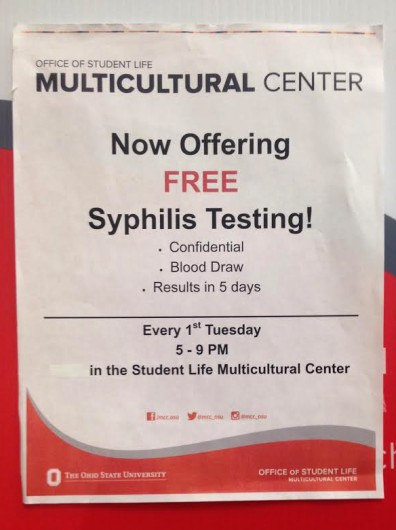
A flyer offering ‘free syphilis testing’ is seen at the Student Wellness Center at the RPAC on Oct. 29.
Credit: Lauren Every / Lantern reporter
Students walking through the RPAC in recent weeks might have noticed a sign outside of the Student Wellness Center that read: “ATTENTION COLUMBUS, SYPHILIS OUTBREAK, GET TESTED.”
Ohio State Student Life spokesman Dave Isaacs said the notice at the Student Wellness Center wasn’t a response to an increase in the number of cases on campus, but rather in the number of cases in the Greater Columbus area.
And Columbus Public Health lists a Columbus syphilis outbreak on its website.
Its most recent release about the outbreak was issued Nov. 4 and said data from the Ohio Department of Health showed a 34 percent increase in cases from January through August, compared to January through August 2013.
Columbus Public Health issued its initial advisory about the outbreak July 10.
Syphilis is a treatable sexually transmitted infection. The infection, which is diagnosed by a blood test, causes lesions, rash and swollen lymph glands. It can also lead to paralysis and blindness if it is not treated.
During 2005–13, the number of primary and secondary syphilis cases reported each year in the United States nearly doubled, from 8,724 to 16,663; the annual rate increased from 2.9 to 5.3 cases per 100,000 population.
Makeda Porter, a prevention services manager of Columbus Public Health’s Sexual Health Program, said since the Columbus advisory was posted, the number of cases have increased.
“We expect actually an uptake in the number of cases that are found because, ideally, what would happen is those numbers are released by the health department and then testing would increase,” Porter said.
Syphilis is highly infectious and can be transmitted through vaginal, anal, oral sex, “heavy petting” and even kissing, Porter said.
Even so, most of the diagnosed cases are in men who have sex with men, she said.
“People need to be practicing safer sex, using a condom. Obviously, it’s going to protect at least the areas covered by the condom but if somebody has a sore outside of the area covered by the condom, there is still a possibility (syphilis) can be transmitted,” Porter said.
During 2010-11, the number of cases of primary and secondary syphilis in men who have sex with other men increased 8 percent from 6,870 to 7,422, according to the CDC website.
Hannah Tippett, a fourth-year in human development and family science, currently works as a prevention intern for AIDS Resource Center Ohio and has had experience testing for STIs and counseling clients about their sexual health.
“I was alarmed when I heard about (the outbreak) because I feel as though college students aren’t concerned about/don’t even think about syphilis when engaging in sexual activity,” Tippett said in an email.
Tippett said ARC Ohio offers syphilis testing through the Columbus Public Health two days a week.
Testing is also offered at the Wilce Student Health Center. Additionally, students can find educational opportunities to learn about sexual health through the Student Wellness Center.
The Student Wellness Center offers different interactive workshops to educate students on sexual health and provides testing for STIs that do not require a blood test, including chlamydia, gonorrhea and HIV.
The Wellness Center also has a program called Condom Club, which offers a discounted rate on condoms. After viewing a short educational video and passing a five-question quiz, students are able to purchase up to 25 condoms per day for $5 with their BuckID.
Leisa DeCarlo contributed to this story.


